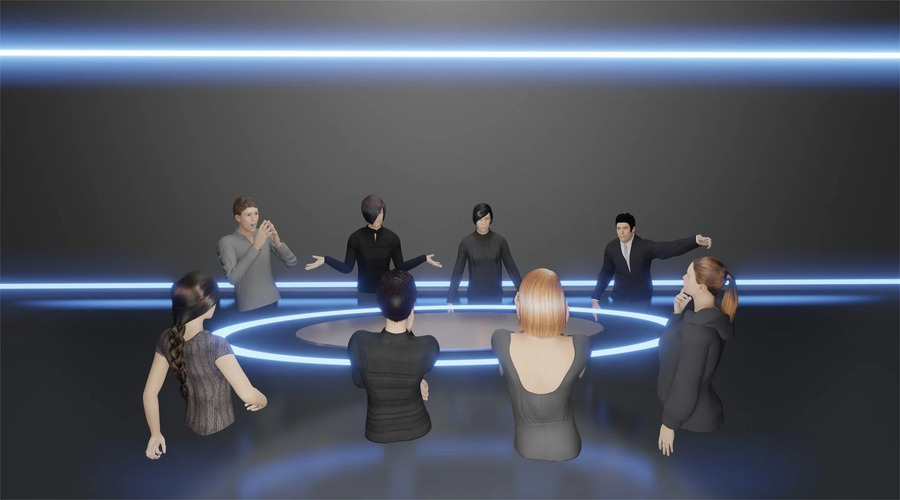
Metaverse Storytelling: Creating Immersive Narratives in Digital Worlds
The metaverse offers a new frontier for storytelling, offering an immersive and interactive environment in which creators can tell stories that blur the line between reality and fiction. In this article, we explore the intersection of the metaverse and storytelling and the potential for the metaverse to transform the way we think about narrative and creative expression.
The Evolution of Storytelling
Storytelling has been a part of human culture for thousands of years, from the oral traditions of ancient civilizations to the printed books and movies of modern times. Over time, storytelling has evolved, with new technologies such as television, video games, and social media changing the way we consume and interact with stories.
The Metaverse and Storytelling
The metaverse represents the next frontier of storytelling, offering a virtual space in which creators can tell stories that are more immersive, interactive, and engaging than ever before. Here are some ways in which the metaverse is impacting the world of storytelling:
Immersive Environments
The metaverse offers creators the ability to create immersive environments that can transport audiences to new worlds and experiences. Virtual reality technology can be used to create 360-degree environments that fully surround the viewer, providing a more immersive and engaging storytelling experience.
Interactive Narratives
The metaverse allows for more interactive and participatory storytelling, allowing audiences to engage with stories in new and exciting ways. Interactive narratives can incorporate elements such as branching storylines, player choice, and real-time decision-making, offering a more engaging and personalized storytelling experience.
Collaborative Storytelling
The metaverse can be used to facilitate collaborative storytelling, allowing creators and audiences to work together to create stories and narratives in real-time. This can lead to more dynamic and unpredictable storytelling experiences, as well as a greater sense of community and collaboration.
Augmented Reality Storytelling
Augmented reality technology can be used to create interactive storytelling experiences that blend the real world with digital elements. This can include things like using AR to enhance physical books, creating AR scavenger hunts, or using AR to create interactive museum exhibits.
The Future of Metaverse Storytelling
As the technology behind the metaverse continues to evolve, we can expect to see even more innovative and creative uses of virtual reality in the world of storytelling. Here are some potential areas for growth and development:
Virtual Reality Theater
Virtual reality theater could be used to create immersive and interactive theatrical experiences, allowing audiences to experience live performances in a virtual environment. Virtual reality theater could also allow for more experimental and avant-garde theatrical experiences, as well as greater accessibility for audiences who may not be able to attend physical performances.
Virtual Reality Storytelling for Education
Virtual reality storytelling could be used to create engaging and interactive educational experiences, allowing students to explore historical events, scientific concepts, and other subjects in a more immersive and memorable way. Virtual reality technology can be used to create interactive simulations, visualizations, and other tools to help students learn and retain information.
Virtual Reality Storytelling for Therapy
Virtual reality storytelling could also be used to help people with mental health issues, providing a safe and immersive environment in which to explore and process emotions and experiences. Virtual reality storytelling could be used to create guided meditations, visualization exercises, and other therapeutic tools.
Virtual Reality Storytelling for Advertising
Virtual reality storytelling can be used in advertising to create more engaging and memorable experiences for consumers. Virtual reality advertisements can be used to transport consumers to immersive brand experiences, or to tell stories that highlight the values and mission of a brand in a more engaging and interactive way.
Virtual Reality Storytelling for Journalism
Virtual reality storytelling can be used in journalism to create more immersive and informative news experiences. Virtual reality technology can be used to create 360-degree video experiences that transport viewers to the center of news events, providing a more visceral and engaging news experience.
Virtual Reality Storytelling for Gaming
Virtual reality storytelling can be used in gaming to create more immersive and interactive gaming experiences. Virtual reality technology can be used to create games that offer more complex and engaging narratives, as well as more realistic and immersive game worlds.
Virtual Reality Storytelling for Museums and Exhibitions
Virtual reality storytelling can be used in museums and exhibitions to create more engaging and informative exhibits. Virtual reality technology can be used to create interactive and immersive exhibits that allow visitors to explore historical events, scientific concepts, and other subjects in a more engaging and memorable way.
Virtual Reality Storytelling for Entertainment
Virtual reality storytelling can be used to create more immersive and engaging entertainment experiences, from movies and TV shows to music videos and live performances. Virtual reality technology can be used to create immersive and interactive entertainment experiences that transport audiences to new worlds and experiences.
Virtual Reality Storytelling for Education
Virtual reality storytelling can be used to create engaging and interactive educational experiences, allowing students to explore historical events, scientific concepts, and other subjects in a more immersive and memorable way. Virtual reality technology can be used to create interactive simulations, visualizations, and other tools to help students learn and retain information.
Advantages of Virtual Reality Storytelling for Education
Virtual reality storytelling offers several advantages for education, including:
- Immersive and engaging learning experiences
- Personalized and adaptive learning environments
- Increased retention and understanding of complex concepts
- Improved accessibility and inclusivity for students with disabilities or learning differences
Examples of Virtual Reality Storytelling for Education
Some examples of virtual reality storytelling for education include:
- VR simulations of historical events, such as the Battle of Gettysburg or the Apollo 11 moon landing
- VR visualizations of scientific concepts, such as the human body or the solar system
- VR language learning experiences, allowing students to practice speaking and listening in a virtual environment
Virtual Reality Storytelling for Advertising
Virtual reality storytelling can be used in advertising to create more engaging and memorable experiences for consumers. Virtual reality advertisements can be used to transport consumers to immersive brand experiences, or to tell stories that highlight the values and mission of a brand in a more engaging and interactive way.
Advantages of Virtual Reality Storytelling for Advertising
Virtual reality storytelling offers several advantages for advertising, including:
- Increased engagement and emotional connection with consumers
- Greater brand awareness and recognition
- Enhanced storytelling capabilities, allowing brands to create more compelling narratives
- Potential for data collection and analysis
Examples of Virtual Reality Storytelling for Advertising
Some examples of virtual reality storytelling for advertising include:
- VR brand experiences, such as the Lexus LC 500 VR Experience, which allows users to explore the car in a virtual environment
- VR product demonstrations, such as the IKEA VR Experience, which allows users to explore and interact with virtual furniture
- VR storytelling campaigns, such as the New York Times’ “The Displaced” project, which tells the stories of child refugees in virtual reality
Conclusion
The metaverse represents a new frontier for storytelling, offering an immersive and interactive environment in which creators can tell stories that blur the line between reality and fiction. Immersive environments, interactive narratives, collaborative storytelling, and augmented reality storytelling are just a few examples of the ways in which the metaverse is impacting the world of storytelling.
Victoria spent the last year and a half I have been working for coinjet.info, a cryptocurrency news site, covering all breaking news content.


